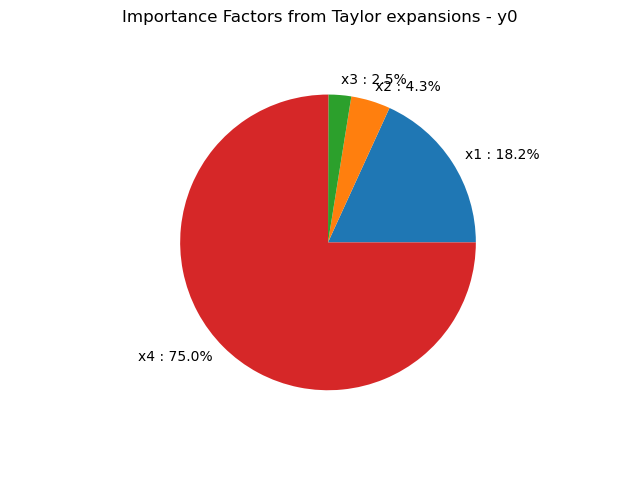Note
Go to the end to download the full example code
Estimate moments from Taylor expansions¶
In this example we are going to estimate mean and standard deviation of an output variable of interest thanks to the Taylor variance decomposition method of order 1 or 2.
Model definition¶
import openturns as ot
import openturns.viewer as viewer
import numpy as np
from matplotlib import pylab as plt
ot.Log.Show(ot.Log.NONE)
Create a composite random vector
ot.RandomGenerator.SetSeed(0)
input_names = ["x1", "x2", "x3", "x4"]
myFunc = ot.SymbolicFunction(input_names, ["cos(x2*x2+x4)/(x1*x1+1+x3^4)"])
R = ot.CorrelationMatrix(4)
for i in range(4):
R[i, i - 1] = 0.25
distribution = ot.Normal([0.2] * 4, [0.1, 0.2, 0.3, 0.4], R)
distribution.setDescription(input_names)
# We create a distribution-based RandomVector
X = ot.RandomVector(distribution)
# We create a composite RandomVector Y from X and myFunc
Y = ot.CompositeRandomVector(myFunc, X)
Taylor expansion based estimation of the moments¶
We create a Taylor expansion method to approximate moments
taylor = ot.TaylorExpansionMoments(Y)
Analysis of the results¶
get 1st order mean
print(taylor.getMeanFirstOrder())
[0.932544]
get 2nd order mean
print(taylor.getMeanSecondOrder())
[0.820295]
get covariance
print(taylor.getCovariance())
[[ 0.0124546 ]]
draw importance factors
taylor.getImportanceFactors()
draw importance factors
graph = taylor.drawImportanceFactors()
view = viewer.View(graph)

Get the value of the output at the mean point
taylor.getValueAtMean()
Get the gradient value of the output at the mean point
taylor.getGradientAtMean()
Get the hessian value of the output at the mean point
taylor.getHessianAtMean()
plt.show()
Using finite difference gradients¶
When no gradient and/or functions are provided for the model, a finite difference approach is relied on automatically. However, it is possible to manually specify the characteristic of the considered difference steps.
def myPythonFunction(X):
x1, x2, x3, x4 = X
return [np.cos(x2 * x2 + x4) / (x1 * x1 + 1.0 + x3**4)]
myFunc = ot.PythonFunction(4, 1, myPythonFunction)
For instance, a user-defined constant step value can be considered
gradEpsilon = [1e-8] * 4
hessianEpsilon = [1e-7] * 4
gradStep = ot.ConstantStep(gradEpsilon) # Costant gradient step
hessianStep = ot.ConstantStep(hessianEpsilon) # Constant Hessian step
myFunc.setGradient(
ot.CenteredFiniteDifferenceGradient(gradStep, myFunc.getEvaluation())
)
myFunc.setHessian(
ot.CenteredFiniteDifferenceHessian(hessianStep, myFunc.getEvaluation())
)
Alternatively, we can consider a finite difference step value which depends on the location in the input space by relying on the BlendedStep class:
gradEpsilon = [1e-8] * 4
hessianEpsilon = [1e-7] * 4
gradStep = ot.BlendedStep(gradEpsilon) # Costant gradient step
hessianStep = ot.BlendedStep(hessianEpsilon) # Constant Hessian step
myFunc.setGradient(
ot.CenteredFiniteDifferenceGradient(gradStep, myFunc.getEvaluation())
)
myFunc.setHessian(
ot.CenteredFiniteDifferenceHessian(hessianStep, myFunc.getEvaluation())
)
We can then proceed in the same way as before
Y = ot.CompositeRandomVector(myFunc, X)
taylor = ot.TaylorExpansionMoments(Y)
Total running time of the script: ( 0 minutes 0.052 seconds)
 OpenTURNS
OpenTURNS